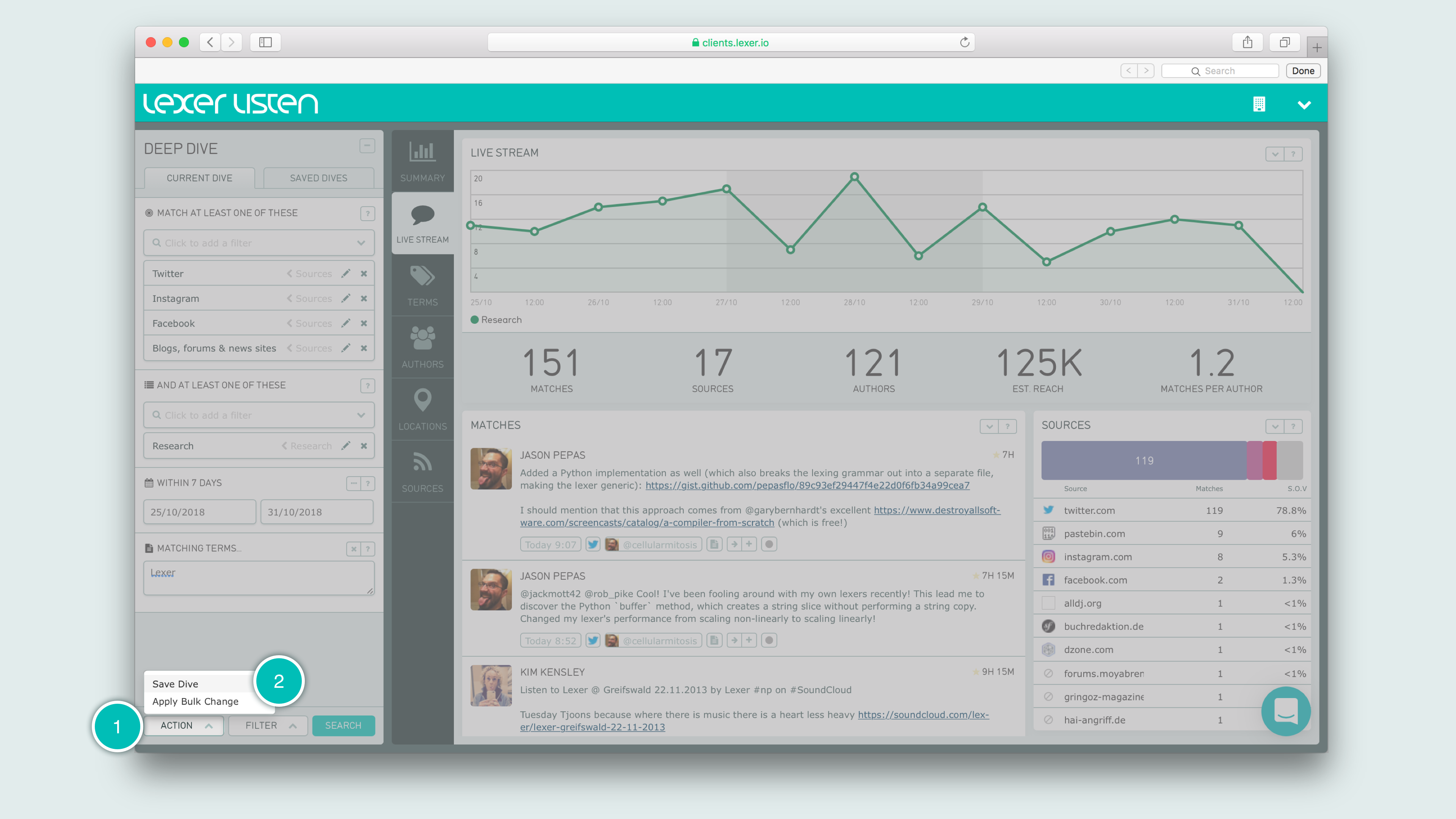Saved dives
Create and save a search to use again, and to power your reports
When you build a search in your Deep Dive in Lexer Listen or Lexer Respond, you can then save this search to use again. We call this a Saved Dive.
Saved Dives can be used to efficiently run the same search - day in, day out. This is particularly useful for customer service workflows, daily reporting, and easy access to the volume of content generated on things like campaigns, media releases, and important topics.
Where to find your Saved Dives
When you land in Lexer Listen, or Lexer Respond, the Deep Dive on the left of your screen will display your Current Dive. This will be compiled of your default Tier Filters, which are the search filters that you’ve chosen to appear by default when you set them up.
Check out our article on Tier Filters to learn more about how to create and edit them.
Searches you’ve previously saved now live in the tab next to the Current Dive, labelled “Saved Dives”. Click here to see your Saved Dives listed out by the categories you’ve saved them to, each in alphabetical order.
You can also pin Saved Dives you use often, so that they sit a the top of this column. Note that the pinned Saved Dives setting creates your own personal “favourites” - your team will not be able to see your pinned Saved Dives.
Building your search
Your search is compiled of at least one Tier 1 Filter, and one Tier 2 Filter.
To hone in further on the content you’re looking for, you can also include additional Tier 3 Filters.
Check out our guide to Searching in Listen to discover the best setup for your use case.
Saving your search as a Saved Dive
Once you’re happy with the search you’ve built, and the results make sense, it’s time to save.

Click the Action button, then select Save Dive.

Give your search a Name, and add a Description to let others know what it’s used for. Then put it into a Category to keep your Saved Dives organized, and click Save.
Editing a Saved Dive
When editing your Saved Dive, we recommend re-running your search with each change you make. This will ensure your results are still relevant, and you can undo the change
Adding filters
To add a saved filter to your search, simply select your pre-saved Tier Filters from the Tier 1 (“match at least one of these”) and Tier 2 (“and at least one of these”) dropdown menus. If you can’t find the Tier Filter you’re looking for, head over to our guide on Creating Tier Filters to set these up now.
To add a new filter on the fly, select the Filter button at the bottom of your Deep Dive, and add your required filter. To find out more about the different filter types, and how to use them, check out our guide to Types of Tier Filters.
Removing filters
This one’s easy - just click on the X on the right of the filter. Just be aware that this action cannot be undone, though if you’ve removed a filter from an existing Saved Dive without re-saving, you can simply select the Saved Dive again from the Saved Dives tab, to re-populate the Deep Dive.
Saving over the existing Saved Dive
To save changes, and override the existing Saved Dive, head to the top right-hand corner of your Deep Dive, and click on the floppy disk icon.
Saving as a new Saved Dive
If others are using the Saved Dive you’d like to change, your best bet is to save your changes as a new Saved Dive, so as to keep the existing Saved Dive, and not to disrupt anyone’s workflow.
To do this, make your changes, then select Action > Save Dive from the bottom of your Deep Dive. Then add the criteria to the form that appears on the right.
Using Saved Dives
Saved Dives are used for a whole variety of different purposes:
- Listen: Run in Listen for instant and detailed insight on content relevant to your interests.
- Respond: Pull in all social, email, and other web content relevant to your company, for customer service teams to work through one, easy to use workflow.
- PDF reports: Share the results returned from your Saved Dives in PDF format.
- Visualize screens: Power live dashboards, and share at scale.

